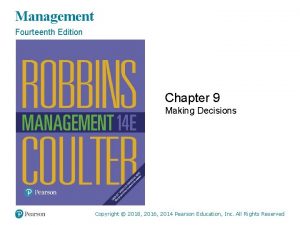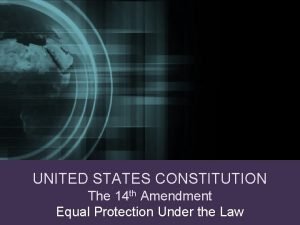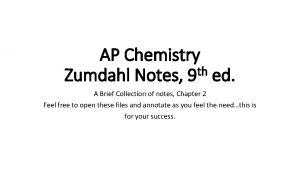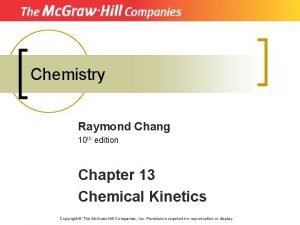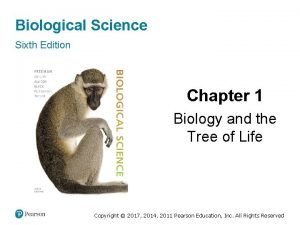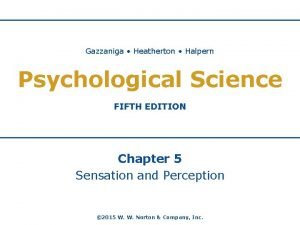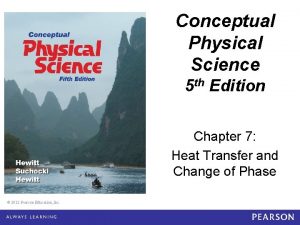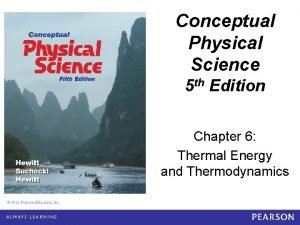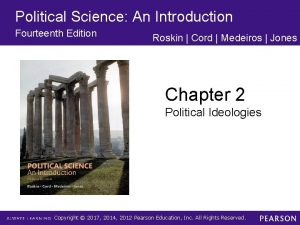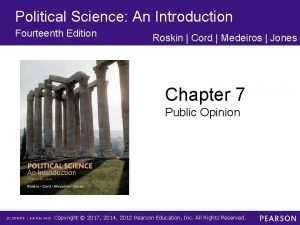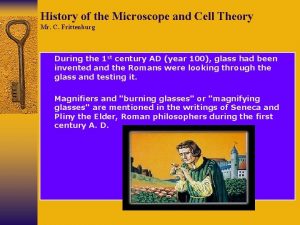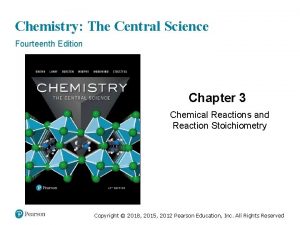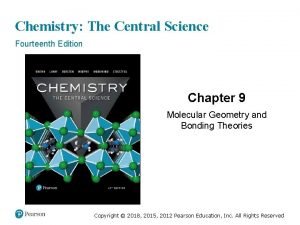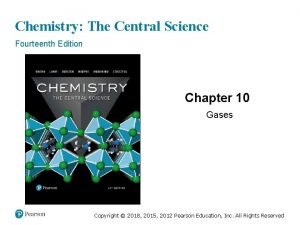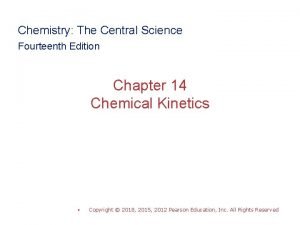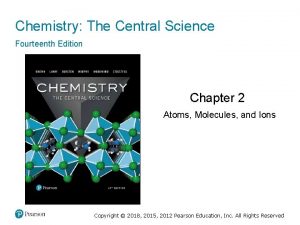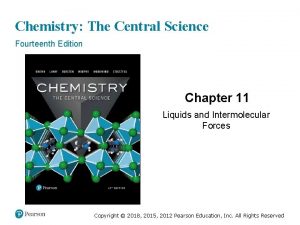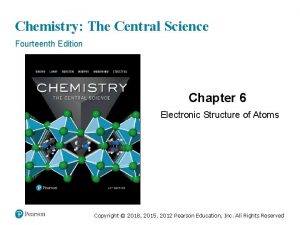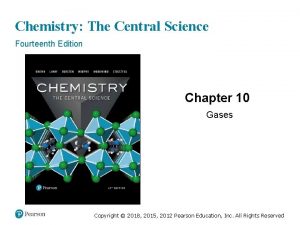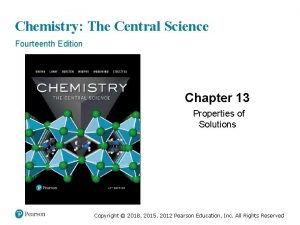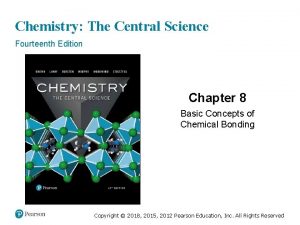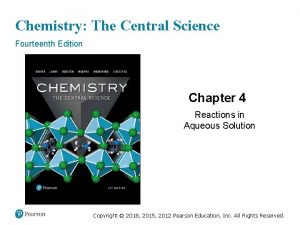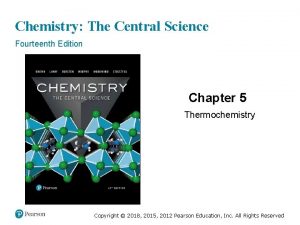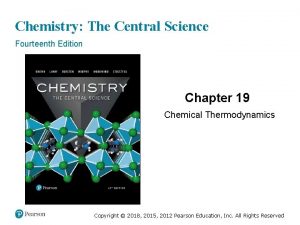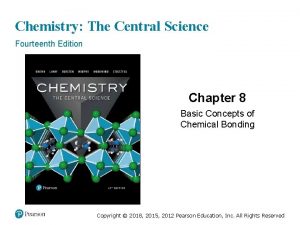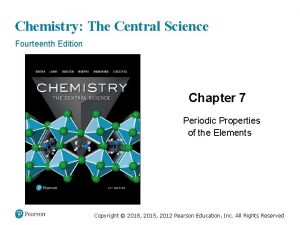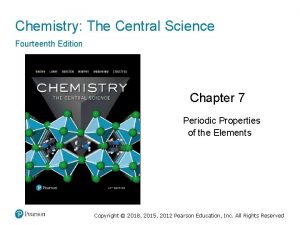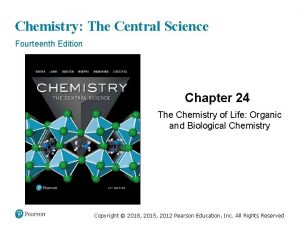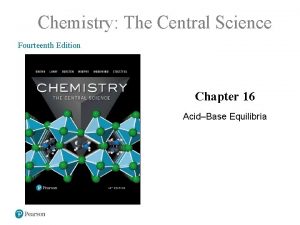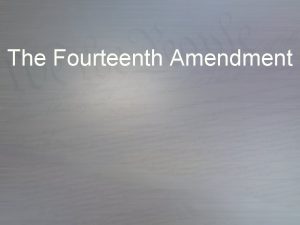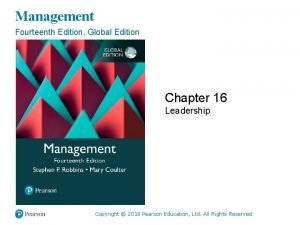Chemistry The Central Science Fourteenth Edition Chapter 1































![Units of Measurement—Metric System Prefixes (3 of 3) [Table 1. 4 continued] a. The Units of Measurement—Metric System Prefixes (3 of 3) [Table 1. 4 continued] a. The](https://slidetodoc.com/presentation_image/98c680b0c7216bd833b115d00761ed8f/image-32.jpg)

















- Slides: 49

Chemistry: The Central Science Fourteenth Edition Chapter 1 Introduction: Matter, Energy, and Measurement Copyright © 2018, 2015, 2012 Pearson Education, Inc. All Rights Reserved

Chemistry • Chemistry is the study of matter, its properties, and the changes it undergoes. • It is central to our fundamental understanding of many sciencerelated fields. Copyright © 2018, 2015, 2012 Pearson Education, Inc. All Rights Reserved

Matter is anything that has mass and takes up space. Copyright © 2018, 2015, 2012 Pearson Education, Inc. All Rights Reserved

Methods of Classification • State of Matter • Composition of Matter Copyright © 2018, 2015, 2012 Pearson Education, Inc. All Rights Reserved

States of Matter • The three states of matter are 1) solid. 2) liquid. 3) gas. • In this figure, those states are ice, liquid water, and water vapor. Copyright © 2018, 2015, 2012 Pearson Education, Inc. All Rights Reserved

Classification of Matter Based on Composition (1 of 2) • If you follow this scheme, you can determine how to classify any type of matter. – Homogeneous mixture – Heterogeneous mixture – Element – Compound Copyright © 2018, 2015, 2012 Pearson Education, Inc. All Rights Reserved

Classification of Matter—Substances • A substance has distinct properties and a composition that does not vary from sample to sample. • The two types of substances are elements and compounds. – An element is a substance which can not be decomposed to simpler substances. – A compound is a substance which can be decomposed to simpler substances because it is made up of more than one element. Copyright © 2018, 2015, 2012 Pearson Education, Inc. All Rights Reserved

Classification of Matter Based on Composition (2 of 2) • Atoms are the building blocks of matter. • Each element is made of a unique kind of atom, but can be made of more than one atom of that kind. • A compound is made of atoms from two or more different elements. Note: Balls of different colors are used to represent atoms of different elements. Attached balls represent connections between atoms that are seen in nature. These groups of atoms are called molecules. Copyright © 2018, 2015, 2012 Pearson Education, Inc. All Rights Reserved

Elements and Composition • There are currently 118 named elements. • Only five elements make up 90% of the Earth’s crust by mass. • Only three elements make up 90% of the human body by mass! • Note the importance of oxygen! Copyright © 2018, 2015, 2012 Pearson Education, Inc. All Rights Reserved

Representing Elements Table 1. 1 Some Common Elements and Their Symbols Carbon C Aluminum Al Copper Cu (from cuprum) Fluorine F Bromine Br Iron Fe (from ferrum) Hydrogen H Calcium Ca Lead Pb (from plumbum) Iodine I Chlorine Cl Mercury Hg (from hydrargyrum) Nitrogen N Helium He Potassium K (from kalium) Oxygen O Lithium Li Silver Ag (from argentum) Phosphorus P Magnesium Mg Sodium Na (from natrium) Sulfur S Silicon Si Tin Sn (from stannum) • Chemists usually represent elements as symbols. • Symbols are one or two letters; the first is always capitalized. • Some elements are based on Latin, Greek, or other foreign language names. Copyright © 2018, 2015, 2012 Pearson Education, Inc. All Rights Reserved

Compounds and Composition • Compounds have a definite composition. That means that the relative number of atoms of each element in the compound is the same in any sample. • This is The Law of Constant Composition (or The Law of Definite Proportions). Copyright © 2018, 2015, 2012 Pearson Education, Inc. All Rights Reserved

Classification of Matter—Mixtures • Mixtures exhibit the properties of the substances that make them. • Mixtures can vary in composition throughout a sample (heterogeneous) or can have the same composition throughout the sample (homogeneous). • A homogeneous mixture is also called a solution. Copyright © 2018, 2015, 2012 Pearson Education, Inc. All Rights Reserved

Two Types of Properties • Physical properties • Chemical properties Copyright © 2018, 2015, 2012 Pearson Education, Inc. All Rights Reserved

Physical Properties • Physical properties can be observed without changing a substance into another substance. – Some examples include color, odor, density, melting point, boiling point, and hardness. Copyright © 2018, 2015, 2012 Pearson Education, Inc. All Rights Reserved

Chemical Properties • Chemical properties can only be observed when a substance is changed into another substance. – One common chemical property is flammability, or the ability to burn in oxygen. Copyright © 2018, 2015, 2012 Pearson Education, Inc. All Rights Reserved

Types of Properties • Intensive properties are independent of the amount of the substance that is present. – Examples include density, boiling point, or color. – These are important for identifying a substance. • Extensive properties depend upon the amount of the substance present. – Examples include mass, volume, or energy. Copyright © 2018, 2015, 2012 Pearson Education, Inc. All Rights Reserved

Types of Changes • Physical changes are changes in matter that do not change the composition of a substance. – Examples include changes of state, temperature, and volume. • Chemical changes result in new substances. – Examples include combustion, oxidation, and decomposition. Copyright © 2018, 2015, 2012 Pearson Education, Inc. All Rights Reserved

Changes in State of Matter • Converting between the three states of matter is a physical change. • When ice melts or water evaporates, there are still 2 H atoms and 1 O atom in each molecule. Copyright © 2018, 2015, 2012 Pearson Education, Inc. All Rights Reserved

This is the end of the lecture Copyright © 2018, 2015, 2012 Pearson Education, Inc. All Rights Reserved

Chemical Reactions (Chemical Change) In the course of a chemical reaction, the reacting substances are converted to new substances. Here, the copper penny reacts with nitric acid; it gives a blue solution of copper(II) nitrate and a brown gas called nitrogen dioxide. Note: Physical properties, like color, often helps us See that chemical change has occurred. Copyright © 2018, 2015, 2012 Pearson Education, Inc. All Rights Reserved

Separating Mixtures • Mixtures can be separated based on physical properties of the components of the mixture. Some methods used are – filtration – distillation – chromatography Copyright © 2018, 2015, 2012 Pearson Education, Inc. All Rights Reserved

Filtration • In filtration, solid substances are separated from liquids and solutions. Copyright © 2018, 2015, 2012 Pearson Education, Inc. All Rights Reserved

Distillation • Distillation uses differences in the boiling points of substances to separate a homogeneous mixture into its components. Copyright © 2018, 2015, 2012 Pearson Education, Inc. All Rights Reserved

Chromatography • This technique separates substances on the basis of differences in the ability of substances to adhere to the solid surface, in this case, dyes to paper. Copyright © 2018, 2015, 2012 Pearson Education, Inc. All Rights Reserved

Energy (1 of 2) • Energy is the capacity to do work or transfer heat. • Work is the energy transferred when a force exerted on an object causes a displacement of that object. • Heat is the energy used to cause the temperature of an object to increase. • Force is any push or pull on an object. Copyright © 2018, 2015, 2012 Pearson Education, Inc. All Rights Reserved

Two Fundamental Forms of Energy • Kinetic energy is the energy of motion. – Its magnitude depends on the object’s mass and its velocity: • Potential energy of an object depends on its relative position compared to other objects. Copyright © 2018, 2015, 2012 Pearson Education, Inc. All Rights Reserved

Numbers and Chemistry • Numbers play a major role in chemistry. Many topics are quantitative (have a numerical value). • Concepts of numbers in science – Units of measurement – Quantities that are measured and calculated – Uncertainty in measurement – Significant figures – Dimensional analysis Copyright © 2018, 2015, 2012 Pearson Education, Inc. All Rights Reserved

Units of Measurements—SI Units • Système International d’Unités (“The International System of Units”) • A different base unit is used for each quantity. Table 1. 3 SI Base Units Physical Quantity Name of Unit Abbreviation Length Meter m Mass Kilogram kg Temperature Kelvin K Time Second s or sec Amount of substance Mole mol Electric current Ampere A or amp Luminous intensity Candela cd Copyright © 2018, 2015, 2012 Pearson Education, Inc. All Rights Reserved

Units of Measurement—Metric System • The base units used in the metric system – – Mass: gram (g) Length: meter (m) Time: second (s or sec) Temperature: degrees Celsius (°C) or Kelvins (K) – Amount of a substance: mole (mol) – Volume: cubic centimeter or liter (l) Copyright © 2018, 2015, 2012 Pearson Education, Inc. All Rights Reserved

Units of Measurement—Metric System Prefixes (1 of 3) Prefixes convert the base units into units that are appropriate for common usage or appropriate measure (as seen with m. L on the can in the last slide). Copyright © 2018, 2015, 2012 Pearson Education, Inc. All Rights Reserved

Units of Measurement—Metric System Prefixes (2 of 3) Table 1. 4 Prefixes Used in the Metric System and with SI Units Copyright © 2018, 2015, 2012 Pearson Education, Inc. All Rights Reserved
![Units of MeasurementMetric System Prefixes 3 of 3 Table 1 4 continued a The Units of Measurement—Metric System Prefixes (3 of 3) [Table 1. 4 continued] a. The](https://slidetodoc.com/presentation_image/98c680b0c7216bd833b115d00761ed8f/image-32.jpg)
Units of Measurement—Metric System Prefixes (3 of 3) [Table 1. 4 continued] a. The watt (W) is the SI unit of power, which is the rate at which energy is either generated or consumed. The SI unit of energy is the joule (J); b. Greek letter mu, pronounced “mew. ” Copyright © 2018, 2015, 2012 Pearson Education, Inc. All Rights Reserved

Mass and Length • These are basic units we measure in science. • Mass is a measure of the amount of material in an object. SI uses the kilogram as the base unit. The metric system uses the gram as the base unit. • Length is a measure of distance. The meter is the base unit. Copyright © 2018, 2015, 2012 Pearson Education, Inc. All Rights Reserved

Volume • Note that volume is not a base unit for SI; it is a derived unit from length • The most commonly used metric units for volume are the liter (L) and the milliliter (m. L). – A liter is a cube 1 decimeter (dm) long on each side. – A milliliter is a cube 1 centimeter (cm) long on each side, also called 1 cubic centimeter Copyright © 2018, 2015, 2012 Pearson Education, Inc. All Rights Reserved

Glassware for Measuring Volume Copyright © 2018, 2015, 2012 Pearson Education, Inc. All Rights Reserved

Temperature (1 of 3) • In general usage, temperature is considered the “hotness and coldness” of an object that determines the direction of heat flow. • Heat flows spontaneously from an object with a higher temperature to an object with a lower temperature. Copyright © 2018, 2015, 2012 Pearson Education, Inc. All Rights Reserved

Temperature (2 of 3) • In scientific measurements, the Celsius and Kelvin scales are most often used. • The Celsius scale is based on the properties of water. – 0 degree Celsius is the freezing point of water. – 100 degree Celsius is the boiling point of water. • The Kelvin is the SI unit of temperature. – It is based on the properties of gases. – There are no negative Kelvin temperatures. – The lowest possible temperature is called absolute zero (0 K). • K = degree Celsius + 273. 15 Copyright © 2018, 2015, 2012 Pearson Education, Inc. All Rights Reserved

Temperature (3 of 3) • The Fahrenheit scale is not used in scientific measurements, but you hear about it in weather reports! • The equations below allow for conversion between the Fahrenheit and Celsius scales: – – Copyright © 2018, 2015, 2012 Pearson Education, Inc. All Rights Reserved

Energy (2 of 2) • The unit of energy: Joule (J). It is a derived unit: – – If the object is 2 kg, and it moves at 1 m/s, it will posses 1 J of kinetic energy: – • The k. J is commonly used for chemical change. • Historically, the calorie was used: 1 cal = 4. 184 J • This calorie is Not the nutritional Calorie. That one is a kcal. • 1 nutritional Calorie = 1 Cal = 1000 cal Copyright © 2018, 2015, 2012 Pearson Education, Inc. All Rights Reserved

Density • Density is a physical property of a substance. • It has units that are derived from the units for mass and volume. • The most common units are g/m. L or • Table 1. 5 Densities of selected Substances at 25 degree Celsius Substance Density ( g / Centimeter cubed ) Air 0. 001 Balsa wood 0. 16 Ethanol 0. 79 Water 1. 00 Ethylene glycol 1. 09 Table sugar 1. 59 Table salt 2. 16 Iron 7. 9 Gold 19. 32 Copyright © 2018, 2015, 2012 Pearson Education, Inc. All Rights Reserved

This is the end of the lecture Copyright © 2018, 2015, 2012 Pearson Education, Inc. All Rights Reserved

Numbers Encountered in Science • Exact numbers are counted or given by definition. For example, there are 12 eggs in 1 dozen. • Inexact (or measured) numbers depend on how they were determined. Scientific instruments have limitations (equipment errors) and individuals can read some instrumentation differently (human errors). Copyright © 2018, 2015, 2012 Pearson Education, Inc. All Rights Reserved

Uncertainty in Measurements • Different measuring devices have different uses and different degrees of accuracy. • All measured numbers have some degree of inaccuracy. • The last digit measured is considered reliable, but Not exact. Copyright © 2018, 2015, 2012 Pearson Education, Inc. All Rights Reserved

Accuracy versus Precision • Precision is a measure of how closely individual measurements agree with one another. • Accuracy refers to how closely individual measurements agree with the correct, or “true, ” value. • Experimentally, we often take several measurements and determine a standard deviation. Copyright © 2018, 2015, 2012 Pearson Education, Inc. All Rights Reserved

Significant Figures (1 of 2) • All digits of a measured quantity, including the uncertain ones, are called significant figures. • When rounding calculated numbers, we pay attention to significant figures so we do not overstate the accuracy of our answers. Copyright © 2018, 2015, 2012 Pearson Education, Inc. All Rights Reserved

Significant Figures (2 of 2) 1. All nonzero digits are significant. 2. Zeroes between nonzero digits are significant. 3. Zeroes at the beginning of a number are never significant. 4. Zeroes at the end of a number are significant if it contains a decimal point. Problem: whole numbers ending in zeroes. 1. 03 times 10 to the fourth grams 1. 0300 times 10 to the fourth grams (three significant figures) (four significant figures) (five significant figures) Copyright © 2018, 2015, 2012 Pearson Education, Inc. All Rights Reserved

Significant Figures in Calculations • The least certain measurement limits the number of significant figures in the answer. • When addition or subtraction is performed, answers are rounded to the least significant decimal place. • When multiplication or division is performed, answers are rounded to the same number of digits as the measurement with the fewest number of significant figures. • Know the number of appropriate digits throughout, but round off at the end only! Copyright © 2018, 2015, 2012 Pearson Education, Inc. All Rights Reserved

Dimensional Analysis • Dimensional analysis is used to change units. • We apply conversion factors (e. g. , 1 in = 2. 54 cm), which are equalities. • We can set up a ratio of comparison for the equality: 1 in. /2. 54 cm or 2. 54 cm/1 in. • We use the ratio which allows us to change units (puts the units we have in the denominator to cancel). • We can use multiple conversions, as long as each one is an equality. Copyright © 2018, 2015, 2012 Pearson Education, Inc. All Rights Reserved

Copyright © 2018, 2015, 2012 Pearson Education, Inc. All Rights Reserved
 Management fourteenth edition
Management fourteenth edition Chapter 1 chapter assessment the central science
Chapter 1 chapter assessment the central science Fourteenth amendment
Fourteenth amendment Summer personification poems
Summer personification poems Organic chemistry (3rd) edition chapter 1 problem 16s
Organic chemistry (3rd) edition chapter 1 problem 16s Reaction of grignard reagent with acid chloride
Reaction of grignard reagent with acid chloride Halohydrin formation
Halohydrin formation What was your favorite subject as a child
What was your favorite subject as a child Using mis 10th edition
Using mis 10th edition Using mis (10th edition)
Using mis (10th edition) Transition state energy diagram
Transition state energy diagram Organic chemistry 2nd edition klein
Organic chemistry 2nd edition klein Introductory chemistry 4th edition
Introductory chemistry 4th edition Prefix multipliers
Prefix multipliers Introductory chemistry 5th edition nivaldo j. tro
Introductory chemistry 5th edition nivaldo j. tro Organic chemistry david klein 3rd edition
Organic chemistry david klein 3rd edition Ap chemistry notes zumdahl
Ap chemistry notes zumdahl Organic chemistry third edition david klein
Organic chemistry third edition david klein General chemistry
General chemistry Lesson 81 drop in molecular views answer key
Lesson 81 drop in molecular views answer key Chemistry by raymond chang 10th edition
Chemistry by raymond chang 10th edition Democritus atomic model diagram
Democritus atomic model diagram Klein organic chemistry 2nd edition
Klein organic chemistry 2nd edition Organic chemistry
Organic chemistry Ib chemistry organic chemistry
Ib chemistry organic chemistry Inorganic vs organic chemistry
Inorganic vs organic chemistry Biological science 6th edition
Biological science 6th edition Rotating snake illusion
Rotating snake illusion When air rapidly expands its temperature normally
When air rapidly expands its temperature normally Microscopic slush in water tends
Microscopic slush in water tends Conceptual physical science 5th edition
Conceptual physical science 5th edition The fundamentals of political science research 2nd edition
The fundamentals of political science research 2nd edition Political science 14th edition
Political science 14th edition Political science 14th edition
Political science 14th edition Science power 9 atlantic edition
Science power 9 atlantic edition Hát kết hợp bộ gõ cơ thể
Hát kết hợp bộ gõ cơ thể Frameset trong html5
Frameset trong html5 Bổ thể
Bổ thể Tỉ lệ cơ thể trẻ em
Tỉ lệ cơ thể trẻ em Chó sói
Chó sói Glasgow thang điểm
Glasgow thang điểm Bài hát chúa yêu trần thế alleluia
Bài hát chúa yêu trần thế alleluia Môn thể thao bắt đầu bằng chữ đua
Môn thể thao bắt đầu bằng chữ đua Thế nào là hệ số cao nhất
Thế nào là hệ số cao nhất Các châu lục và đại dương trên thế giới
Các châu lục và đại dương trên thế giới Công thức tính thế năng
Công thức tính thế năng Trời xanh đây là của chúng ta thể thơ
Trời xanh đây là của chúng ta thể thơ Cách giải mật thư tọa độ
Cách giải mật thư tọa độ Phép trừ bù
Phép trừ bù Phản ứng thế ankan
Phản ứng thế ankan
